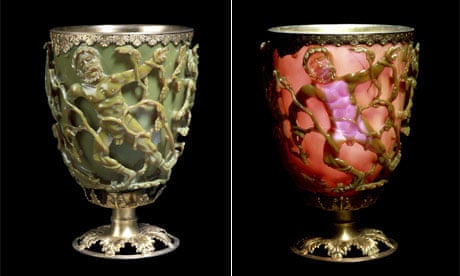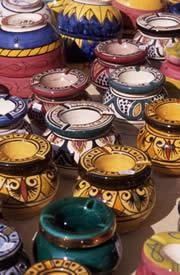Week 8: NanoTech & Art
Nanotechnology can best be described as involving which structures, devices, and systems with novel properties and functions due to the arrangement of their atoms on the 1–100 nm scale. After viewing this week's materials, I found myself most fascinated by the concept of nanoparticles in art, primarily in ancient art. It gives an understanding that although there was no research done on it at the time, these concepts still existed in early art forms.
Much of early art features nanoparticles to enhance color and other visuals, especially in artwork like ceramics and dishes. Primarily, nanoparticles were used in glazes to add metallic sparkle; copper and silver nano particles were envisioned in Renaissance era paintings, and the Roman Lycurgus Cup utilized gold nanoparticles to enhance the red color of the goblet. There is much science behind artistic concepts that have existed for centuries, even before there was an explanation or term for the processes used in ancient art.
Nanoparticles and nanotechnology in art demonstrate to me the idea of collectivism; if not for the presence of hundreds of thousands of nanoparticles, these effects would not be visible to the human eye. It is only because so many of these small particles are being used in one concentrated area that we are able to appreciate its beauty.
Works Cited
Daw, Rosamund. “Nanotechnology is ancient history | Nanotechnology World.” The Guardian, 23 April 2012, https://www.theguardian.com/nanotechnology-world/nanotechnology-is-ancient-history. Accessed 21 May 2024.
Gimzewski, James. “Nanotech for Artists Part 1.” Nanotech + Art. 21 May 2012. Lecture.
Gimzewski, James. “Nanotech for Artists Part 3.” Nanotech + Art. 21 May 2012. Lecture.
Gimzewski, James. “Nanotech for Artists Part 4.” Nanotech + Art. 21 May 2012. Lecture.
“Early Nanomaterials.” International Institute for Nanotechnology, https://www.iinano.org/pre-18th-century/. Accessed 21 May 2024.
“The History of Nanoscience and Nanotechnology: From Chemical–Physical Applications to Nanomedicine.” NCBI, 27 December 2019, https://www.ncbi.nlm.nih.gov/pmc/articles/PMC6982820/. Accessed 21 May 2024.
“Nanoeffects in Ancient Technology and Art and in Space.” ScienceDirect, 5 March 2024, https://www.sciencedirect.com/science/article/pii/B9780323480574000165. Accessed 21 May 2024.
“Renaissance potters were nanotechnologist.” Nature, 5 March 2024, https://www.nature.com/articles/news030623-17. Accessed 21 May 2024.




Hi!
ReplyDeleteI really enjoyed reading your blog which reflects on how nanotechnology incorporated in an art form has been seen thousands of years ago though ceramics and paintings on walls. By mentioning how various civilizations used nanotechnology in the process of making these silvery, I realized that a lot of scientific innovations we have been researching into might have always existed for centuries in forms that were not noticed. It sparked an interest in knowing how did these ceramics get created and how their version of nanotechnology can be viewed differently from what we define nanotechnology as.
I agree! It's amazing how early artists intuitively used nanoparticles to enhance the work, like the metallic sparkle in Renaissance paintings and the Lycurgus Cup's red color. The images you chose were absolutely fascinating. Showcasing the connection between art and science and its deep historical roots.
ReplyDeleteHi Helena! I resonated with how you pointed out the use of science in art before humans even knew what it was. I think it's fascinating especially now that scientists have learned it is the use of nanoparticles and their properties to enhance the art. I also love how you pointed out that it is truly the use of collectivism that allows for this to happen! I relate this idea of collectivism we see here to other uses of it in art whether it be through many artists, many mediums, etc. Thanks for sharing!
ReplyDeleteHi Helena,
ReplyDeleteIt is definitely fascinating how ancient artists unknowingly used nanotechnology. Your analogy about collectivism was thought-provoking, and I think it really emphasized the power of unity. It is a testament to the timeless intersection of art and science. After this week's lectures and reading material, it made me think about what other ancient practices might have unknowingly used scientific concepts such as nanotechnology.